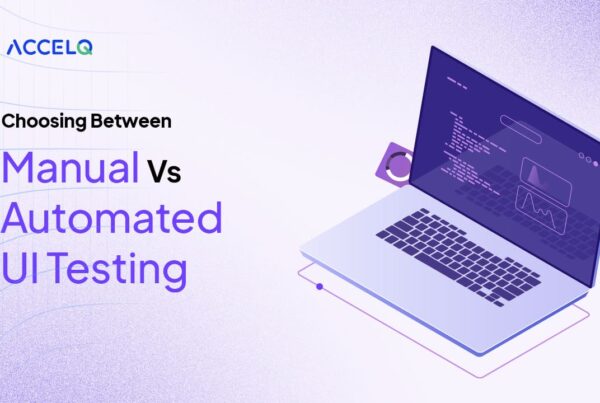Myths about Test Automation Accelerators

Every business strives to reduce time-to-market, aiming to gain a competitive edge and establish a strong brand presence.
The desire to capture user attention, cultivate customer loyalty, and refine products drives this vision.
Alongside the imperative to optimize budget, ensure consistent and continuous delivery, and foster product innovation, businesses are increasingly drawn to test accelerators. These frameworks offer a comprehensive set of best practices, including early automation, promising to expedite testing processes and facilitate faster speed-to-market.
- Myth 1 – Test Accelerators Garner Immediate ROI
- Myth 2 – Test Accelerators Are One-Size-Fits-All
- Myth 3 – Test Case Count Is Everything
- Myth 4 – Test Accelerators Are Highly Customized
- Myth 5 – Test Accelerators Are a One-Time Investment
- Myth 6 – Test Accelerators Are Unified
- ACCELQ Live – A Fresh Breath
Unveiling the Myths of Test Accelerators
Despite their enticing promises, test accelerators are often marketed with vague or misleading claims. The rush to adopt these tools may come at a cost, as their efficacy and value are not always as straightforward as advertised. To unravel the discourse surrounding test accelerators and shed light on the industry's promotion strategies, it is essential to examine the myths associated with their usage. In doing so, we can gain a deeper understanding of the potential challenges and limitations that accompany these frameworks.

Myth 1 - Test Accelerators Garner Immediate ROI
Often, vendors of test acceleration frameworks suggest that their suite of libraries, frameworks, and services will immediately produce a tangible return on investment (ROI). But what justifies such a claim?
Sure, test accelerators contribute to the end-to-end test automation strategy and the notion of increasing the ROI. But will you get significant returns for your investment quickly? Unfortunately, it’s not very likely. So, before you buy into the idea of test accelerators being a quick-win, consider how long it takes to realize value from them.
Myth 2 - Test Accelerators Are One-Size-Fits-All
The idea that test accelerators are a panacea for all the complex requirements is inaccurate. Even if the underlying platform (e.g., Salesforce) is a common thread in the product ecosystem, customizations and bespoke features cannot be implemented via a solitary workflow.
After all, every business has its own needs and objectives. Therefore, the performance of test accelerators depends on the workflow design’s sophistication.
Do more with Test Automation
Discover more ways to add ‘low-code no-code‘ test automation in your workflows

Myth 3 - Test Case Count Is Everything
What is often proposed to measure the performance of an accelerator is the number of test cases it can execute. The logic behind this measurement is that every execution consumes resources and hence consumes money.
But a high test case count does not guarantee the quality implementation of any business application. First, over-quantification deviates from the idea that the “amount” of test cases must depend on whether they address the functional/non-functional needs or not.
Second, this approach is flawed as all tests are not created equal. A high test case count with low test quality is of little value to the business. So, be careful when using such a metric and evaluate the quality of the test cases against expected results.
Myth 4 - Test Accelerators Are Highly Customized
By now, we’ve understood that customization is a critical parameter to judge adherence to business needs. But unfortunately, many vendors make their test accelerators appear as a silver bullet. They do so by deploying an army of testers to bolster the idea of “customization.”
Soon, a sub-quality automation suite developed on a sub-quality utility is promoted as the solution for the business. Such an approach not only deceives the customer but also triggers an avalanche of problems further down the road.
For one, there’s “dependency” as you’re married to the vendor’s testing toolset. Second, there’s “stickiness” as you’re stuck to a product no matter how inflexible and stringent it is. So, before you blindly agree to the sub-optimal yet over-hyped test accelerators, ensure that buzzwords like “customization” are backed by traction and tangible outputs.
Myth 5 - Test Accelerators Are a One-Time Investment
Well, they aren’t. Most test accelerators are static and have an “all or none” proposition. Once a workflow is implemented, the test automation suite and the utility are there at all times. Indeed, this shouldn’t be the case considering the modern-day business agility that’s entailed across every touchpoint.
As a result, businesses are necessitated to handle the same sub-par testing suite supported by an army until a more beneficial option is available. But again, this is where things get sticky (hence the “stickiness” argument above) and, of course, costly.
Myth 6 - Test Accelerators Are Unified
It wouldn’t be wise to assume that test accelerators are a unified and cohesive entity. Again, they are not a “one size fits all” solution as every business has its own needs and objectives. Most importantly, they aren’t integrated end-to-end and are instead fragmented into components.
As the business requirements evolve, these fragments or components must be updated and integrated. The question looms whether they will comply with the new requirements or be left in the lurch. More often than not, the latter is true.
ACCELQ Live - A Fresh Breath
All the above myths and the implied promises of test accelerators manifest a market frenzy. Driven by the fear of missing out on the “next big thing,” many companies have lost their way in the quest for a faster product release.
But there is a better option. ACCELQ Live brings a dynamic, agile, and responsive engine of automation frameworks that integrate seamlessly across all enterprise packaged apps and custom apps.
Talk about:
- Developing a business flow to cater to a specific need
- Improving the performance of test cases
- Executing a quick turnaround after fix
- Avoiding unnecessary costs for test execution and maintenance of test tools
- Accelerating by eliminating the automation logic for core interactions and functions on the underlying ERP platform, and
- Implementing reusability at a test-asset level, instead of the test-case level
With ACCELQ Live, you can create a scalable, high-performing test automation platform that can handle both the “present” and the “future” of business applications. By keeping in sync with the business requirements at every step, ACCELQ Live gives new direction to test acceleration,
Indeed, the saying “Efficiency is doing things right; effectiveness is doing the right things” befits what businesses can achieve with ACCELQ Live.
Geosley Andrades
Director, Product Evangelist at ACCELQ.
Geosley is a Test Automation Evangelist and Community builder at ACCELQ. Being passionate about continuous learning, Geosley helps ACCELQ with innovative solutions to transform test automation to be simpler, more reliable, and sustainable for the real world.
Related Posts
 Choosing Between Manual Vs Automated UI Testing
Choosing Between Manual Vs Automated UI Testing
Choosing Between Manual Vs Automated UI Testing
 Top 10 QA Metrics Stakeholders Must Track in 2025
Top 10 QA Metrics Stakeholders Must Track in 2025





































